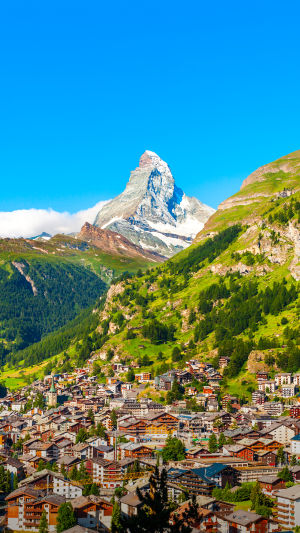Lykkers, imagine riding a train through a bright valley while icy ridges tower overhead and tiny wooden villages cling to the slopes.
This is Valais, stretching along the Rhône from its glacier source to Lake Geneva, and mixing French and German culture in one dramatic canton. Here is how to turn that picture into a real trip, with concrete costs, opening hours, and transport that actually makes sense.
<h3>Valais snapshot</h3>
Roughly one‑fifth of Valais is covered in ice, yet the central valley gets some of Switzerland’s lowest rainfall and highest sunshine hours. Massive dams store snowmelt above, while the lower slopes are lined with terraces, small towns and long‑running mountain railways.Famous resorts like Zermatt, Verbier and Crans‑Montana sit high above the Rhône, but quieter side valleys still feel surprisingly untouched. The main urban hub is Sion, a relaxed capital with a compact old quarter and excellent connections by train and bus.
<h3>When to visit</h3>
December to March is prime for snow, especially around Verbier, Crans‑Montana, Saas‑Fee, Zermatt and the cross‑country tracks of Goms. Expect higher hotel and lift prices then, plus busier slopes in school holidays. Late spring and summer bring hiking, cycling and cable‑car trips with long daylight, making June–September ideal for trail‑focused trips. Autumn stays sunny and dry in the valley, with cooler nights and fewer visitors, so it is perfect for scenic drives, calmer walks and better room deals.
<h3>Key regions</h3>
Haut‑Léman and the Alpes Vaudoises form the western gateway, with Aigle, Villars, Les Diablerets and Leysin between Lake Geneva and inner Valais. Central Valais Romand stretches from Martigny past Sion to Sierre, covering the broad Rhône floor and foothills, and feeding up to Verbier and Crans‑Montana. Oberwallis begins east of Sierre, with Brig as a rail hub and side valleys leading to Zermatt, Saas‑Fee and the quiet Goms region near the Rhône glacier.
<h3>Must‑see spots</h3>
In Martigny, Fondation Pierre Gianadda combines major rotating art exhibitions with sculpture and archaeological collections. From 1 May to 31 October 2025 it opens daily 10:00–18:00, with standard entry 20 CHF, 18 CHF for seniors, 12 CHF for ages 10+ and students, and 42 CHF family tickets.
Sion offers a sunny valley‑floor base, attractive streets and easy access by train to side valleys and small resorts. Nearby Sierre is quieter and connects by funicular to Crans‑Montana, giving you the option to stay low and head up only on clear days. Zermatt is the classic car‑free village below the Matterhorn; winter day passes in the Matterhorn ski area start around 88 CHF in lower‑priced periods and rise on peak dates. Saas‑Fee, in the next valley, offers similar high‑mountain scenery, gentle village streets and lifts serving both snow sports and summer viewpoints.
<h3>Great day trips</h3>
South of Aigle, Bex hides Switzerland’s only working salt mine, with about 50 km of tunnels under the mountains. Standard guided visits include a short film, a mine train ride and roughly two hours underground; tickets are around 26 CHF, children 6–15 about 13 CHF, and under‑6s free. Most seasons, tours run mainly between 09:00 and 17:00 on set days, so reservations are recommended.
Near Sion, Lac Souterrain de Saint‑Léonard is one of Europe’s largest underground lakes. From 19 March to 2 November 2025 it opens daily 10:00–17:00, with 30‑minute boat tours that must be pre‑booked online; pay about 12 CHF, children 5–15 around 7 CHF, and under‑5s go free.
Walkers can follow the 6 km vineyard path between Sierre and Salgesch, linking two halves of a landscape museum and passing viewpoints and a small artist museum in Veyras. Farther south, the Val d’Anniviers leads to Zinal, a classic trailhead village surrounded by big peaks and traditional settlements. For drivers, the Grand‑Saint‑Bernard and Simplon passes offer sweeping bends, high lakes and engineering landmarks like the Ganter Bridge near Brig.
<h3>Getting around</h3>
Valais is stitched together by excellent public transport, with InterCity and regional trains, PostBus routes and numerous lifts and funiculars. For broader Swiss itineraries, the Swiss Travel Pass gives unlimited travel by train, bus and boat; in 2025, 2nd‑class passes start at 244 CHF for 3 consecutive days, with longer options up to 15 days. This pass also includes or discounts entry to many museums and mountain railways, which helps if you plan several scenic rides.
If you are focusing on the western side near Lake Geneva and the Alpes Vaudoises, the Regional Pass Lake Geneva–Alps is often better value. 2nd‑class passes start at 110 CHF for 5 days or 136 CHF for 7 days, mixing some fully free days with others at 50% off, and cover routes to Aigle, Leysin, Les Diablerets, Villars and Saint‑Maurice. Drivers heading east can skip steep climbs by using car‑carrying trains through the 15.4 km Furka Base Tunnel between Oberwald and Realp, or between Andermatt and Sedrun to avoid the Oberalp Pass, with typical journey times of about 15–60 minutes.
<h3>Stays & food</h3>
Prices vary widely between low‑lying towns and big resorts, but some averages help with planning. Across Valais, 3‑star hotels average around 169 GBP (roughly 215 USD) per night on busy weekends, with cheaper deals in shoulder months and weekday stays. HotelsCombined lists an average overall nightly rate near 385 USD once you include higher‑end properties, especially in famous ski areas. In Zermatt alone, typical hotel rates average about 244 USD per night, with mid‑range stays around 259 USD and high‑season prices rising toward 455 USD.
Budget travelers can look for valley towns such as Sion or Martigny, where simple hotels and hostels are often closer to 120–180 CHF per night for two, especially outside peak winter and major events. Apartments and chalets in resorts can be cost‑effective for groups, though minimum‑stay rules in winter are common.
So, pack your bags and get ready to explore the breathtaking beauty and rich culture of Valais. Enjoy your trip!





